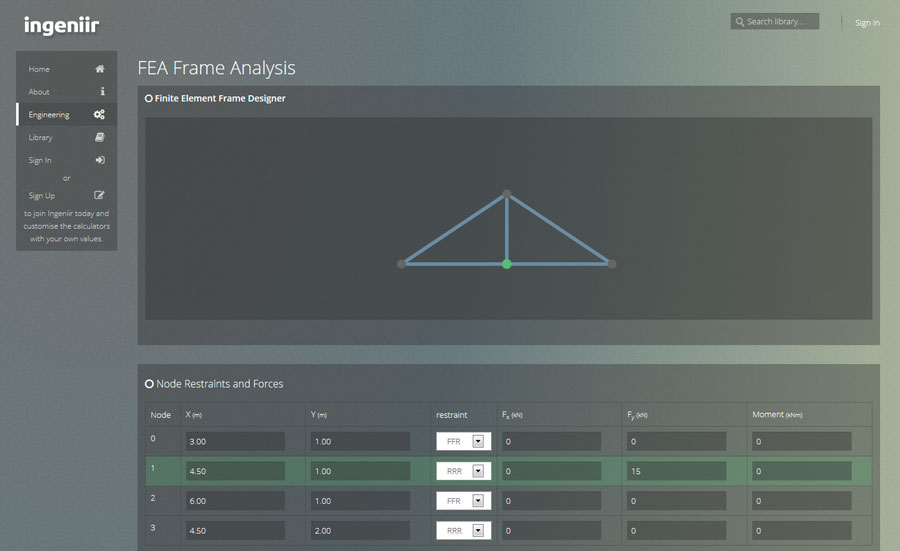New results display in FEA frame designer

New results displays now on the Finite Element Analysis Frame and Truss Designer.
All node deflections and member forces are now shown graphically, the model will also automatically subdivide your members for you, so you can just do a straight UDL and get the mid-span deflection without manually putting a node there. There is also another new feature which allows you to reset the model after analysis so you can alter geometry etc as needed!
I am currently working on the ability to save your models too, so if you are signed in you can revisit models, and possibly even send them to others to review. Stay tuned.
Posted on September 5, 2014
Solar Power de-throning coal in QLD
If you think about it Solar power is a logical solution for energy production. Costs to store energy are becoming cheaper and more commercially viable, and will continue to do so due to the increasing production and development of battery technology driven by electric cars. It no longer makes sense to transmit centrally generated power over long distances or through complex networks when the end user can generate and store their own power.
Last week the daytime cost of electricity went negative due to the clear sunny winter we have been having in Queensland. This to me is signalling the beginning of the end for coal fired power stations. Why would you continue to mine coal, damaging the environment through excavation and burning, transmit power (with losses) and still have to maintain an ageing power supply grid when you can generate power at the location it is needed. Of course coal mining and burning companies are putting up resistance to Solar Energy, but of course it is in their best interests to mine coal until there is none left.
Here is an idea, why don’t the companies who own the electricity networks invest in industrial scale electricity storage which can be fed from, and feed into the existing network and embrace the coming sustainable revolution?
Pumped hydro storage has been in use since the 60’s in Australia and could possibly even be used in conjunction with existing water reticulation networks, how many towns do you know that have tank based water supply? Why not generate power during its use?
Posted on July 8, 2014
Structural Search Engine
Ingeniir now has a new structural section search engine. At the moment it is primarily geared towards steel sections from various regions, however I will be expanding it to include timber sections too. Check it out here!.
Features include being able to earmark sections to remain on screen whilst searching for more sections to compare properties. I will also work on getting the units displayed in the tables too, but don’t hold your breath I’m not too sure how to do it yet. If there are any libraries you would like added just post them in the comments below, prefferably with a link to a csv file or the data in some form that I don’t have to manually extract. Enjoy!
Posted on July 1, 2014
Finite Element Frame Designer
FEA Incoming
Hi everyone, lately I have been pretty busy trying to push out a finite element frame designer. It is almost at beta stage, I will likely release it at beta and continue working on a steel member library which will be implemented to aid in the input of section properties. Anyway here is a screenshot as it currently stands.
It is a pretty flexible editor, and will allow you to do any 2D shape you like. Outputs of the degin will be node deflections, including rotation, member forces and node reactions. It will be a little different from your traditional Finite Element programs, in that you will need to place a node at every point of interest, such as the where you think will be the point of maximum deflection, where a force is applied (if it is not a UDL) or where a moment is applied. But it will be pretty easy to move nodes and recalculate allowing you to find the maximum deflection pretty easily with a couple of iterations. The reason for the node input like this is that finite element models that consist of nodes and links are more accurate with the least amount of nodes, and alot of the time you should already know where the maximum deflection will occur. Keep your eyes peeled for the launch, I will be posting on here and on facebook when it comes live!
Posted on May 8, 2014
Popular Pages
- Manning's Pipe Flow Calculator
- Colebrook-White Pipe Flow Calculator
- Load Calculator
- Open Channel Flow Calculator
- Rainfall Runoff Calculator Rational Method
- Finite Element Analysis Frame Designer
- Ingeniir Engineering Library
- Rainfall Intensity Calculator Kinematic Wave Equation
- AS4100 Steel Compressive Capacities
- Structural Section Search
Popular Library Documents
- Segmental Shaft Installation Guide (PDF 3MB)
- Stramit Wall Sheeting And Cladding Western Region Product Technical Manual
- OneSteel Design Booklet 1.3
- Community Bushfire Refuges 2014
- StormTrap Installation Guide - DoubleTrap (PDF 1MB)
- Technical Report No 5, Treated Timber In Australia : CCA And The Alternatives
- Bondor Equideck Brochure
- Marine Plywood In Boats
- TBMM Part 2: Component Maintenance
- HySPAN Solutions Range Specification

